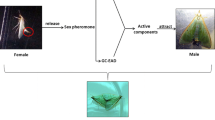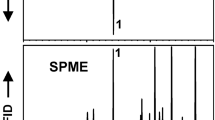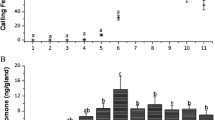Abstract
The behavioral and electrophysiological activity of a mimic [(Z,E)7,9,11-dodecatrienyl formate] of the major sex pheromone component [(Z,E) 9,11,13-tetradecatrienal] of carob moth was assessed. Wind-tunnel bioassays demonstrated that the formate was as effective as natural gland extracts, and significantly more effective than the trienal alone or than the trienal blended with two minor pheromone components, in evoking source contact. Dispensers containing the formate were as effective as trienal-containing blend lures in attracting males when placed at the same dosage in traps in date gardens. Single-cell recordings showed that at least two olfactory neurons, differentiated by spike amplitude, are located in the long trichoid hairs on male carob moth antennae. Dose-response relationships indicated that puffs from cartridges loaded with at least 0.1 μg of the formate or of the trienal were necessary to elicit spiking by either the small or the large-spiking cell within a sensillum. Cross-adaptation studies demonstrated that both compounds stimulated the same large-spiking cell. The frequencies of spikes evoked from the large cell when stimulated by emissions from 0.1-μg, 1-μg, or 10-μg cartridges of either the formate or the trienal were not significantly different, suggesting that the formate is an effective mimic of the trienal at the antennal receptor cell level.
Similar content being viewed by others

References
Abrams, S.R., andShaw, A.C. 1988. Triple bond isomerizations: 2- to 9-decyn-1-ol.Org. Synth. 66:127–131.
Baker, T.C. 1989. Sex pheromone communication in Lepidoptera: New research progress.Experientia 45:248–262.
Baker, T.C., andLinn, C.E., Jr. 1984. Wind tunnels in pheromone research, pp. 75–110,in H.E. Hummel and T.A. Miller (eds.). Techniques in Pheromone Research. Springer-Verlag, New York.
Baker, T.C., Hansson, B.S., Löfstedt, C., andLöfqvist, J. 1989a. Adaptation of male moth antennal neurons in a pheromone plume is associated with cessation of pheromone-mediated flight.Chem. Senses 14:439–448.
Baker, T.C., Francke, W., Löfstedt, C., Hansson, B.S., Du, J.-W., Phelan, P.L., Vetter, R.S., andYoungman, R. 1989b. Isolation, identification and synthesis of sex pheromone components of the carob moth,Ectomyelois ceratoniae.Tetrahedron Lett. 30:2901–2902.
Baker, T.C., Francke, W., Millar, J.G., Löfstedt, C., Hansson, B.S., Du, J.-W., Phelan, P.L., Vetter, R.S., Youngman, R., andTodd, J.L. 1991. Identification and bioassay of sex pheromone components of carob moth,Ectomyelois ceratoniae (Zeller).J. Chem. Ecol. 17:1973–1988.
Bengtsson, M., Liljefors, T., andHansson, B.S. 1987. Dienic analogs of (Z)-5-decenyl acetate, a pheromone component of the turnip moth,Agrotis segetum: Synthesis, conformational analysis and structure-activity relationships.Bioorg. Chem. 15:409–422.
Bevington, J.C. 1952. The polymerization of aldehydes.Chem. Soc. Q. Rev. 6:141–156.
Cardé, R.T. 1990. Principles of mating disruption, pp. 47–71,in R.L. Ridgway, R.M. Silverstein, and M.N. Inscoe (eds.). Chemicals for Insect Management. Marcel Dekker, New York.
Cardé, R.T., andRoelofs, W.L. 1977. Attraction of redbanded leafroller moths,Argyrotaenia velutinana, to blends of (Z)- and (E)-11-tridecenyl acetates.J. Chem. Ecol. 3:143–149.
Dhouibi, M.H. 1982. Etude bioecologique d'Ectomyeloisceratoniae (Zeller) (Lepidoptera, Pyralidae) dans les zones presahariennes de la Tunisie. Thèse de Docteur-Ingénieur. Université Pierre et Marie Curie, Paris, 164 pp.
Doolittle, R.E., Brabham, A., andTumlinson, J.H. 1990. Sex pheromone ofManduca sexta (L): Stereoselective synthesis of (10E,12E,14Z)-10,12,14-hexadecatrienal and isomers.J. Chem. Ecol. 16:1131–1153.
Dunkelblum, E., Kehat, M., Klug, J.T., andShani, A. 1984. Trimerization ofEarias insulana sex pheromone, (E,E)-10,12-hexadecadienal, a phenomenon affecting trapping efficiency.J. Chem. Ecol. 10:421–428.
Ephrussi, B., andBeadle, G.W. 1936. A technique of transplantation forDrosophila.Am. Nat. 70:218–225.
Gothilf, S. 1984. Biology ofSpectrobates ceratoniae on almonds in Israel.Phytoparasitica 12:77–87.
Grant, A.J., Mayer, M.S., andMankin, R.W. 1989. Responses from sensilla on antennae of maleHeliothis tea to its major pheromone component and two analogs.J. Chem. Ecol. 15:2625–2634.
Hansson, B.S., Löfstedt, C., andRoelofs, W.L. 1987. Inheritance of olfactory response to sex pheromone components ofOstrinia nubilalis.Naturwissenschaften 74:497–499.
Hansson, B.S., Szöcs, G., Schmidt, F., Francke, W., Löfstedt, C., andTöth, M. 1990. Electrophysiological and chemical analysis of sex pheromone communication system of the mottled umber,Erannis defoliaria (Lepidoptera: Geometridae).J. Chem. Ecol. 16:1887–1897.
Herscovici, J., Egron, M.J., andAntonakis, K. 1982. New oxidative systems for alcohols: Molecular sieves with chromium(VI) reagents.J. Chem. Soc. Perkin Trans. 1:1969–1973.
Honda, H., Ando, T., Ogura, Y., Teramine, T., andUeda, R. 1990. Identification of the sex pheromone of the mulberry pyralid,Glyphodes pyloalis Walker (Lepidoptera: Pyralidae).Appl. Entomol. Zool. 25:265–272.
Ideses, R., andShani, A. 1988. Chemical protection of pheromones containing an internal conjugated diene system from isomerization and oxidation.J. Chem. Ecol. 14:1657–1669.
Kaissling, K.-E. 1974. Sensory transduction in insect olfactory receptors, pp. 243–273,in L. Jaenicke (ed.). Biochemistry of Sensory Functions. Springer-Verlag, Berlin.
Kaissling, K.-E., Hildebrand, J.G., andTumlinson, J.H. 1989. Pheromone receptor cells in the male mothManduca sexta.Arch. Insect Biochem. Physiol. 10:273–279.
Kobayashi, A., Nohara, K., Ohsumi, E., andYamanishi, T. 1990. Identification of di(l-oxy-alkyl)-peroxides in the essential oil ofCitrus iyo.Agric. Biol. Chem. 54:561–562.
Kubisa, P., Neeld, K., Starr, J., andVogel, O. 1980. Polymerization of higher aldehydes.Polymer 21:1433–1447.
Kuenen, L.P.S., andBaker, T.C. 1982. Optomotor regulation of ground velocity in moths during flight to sex pheromone at different heights.Physiol. Entomol. 7:193–202.
Landolt, P.J., Curtis, C.E., Coffelt, J.A., Vick, K.W., andDoolittle, R.E. 1982. Field trials of potential navel orangeworm mating disruptants.J. Econ. Entomol. 75:547–550.
Liljefors, T., Thelin, B., andVan der Pers, J.N.C. 1984. Structure-activity relationships between stimulus molecule and response of a pheromone receptor cell in turnip moth,Agrotis segetum. Modifications of the acetate group.J. Chem. Ecol. 12:1661–1675.
Liljefors, T., Thelin, B., Van der Pers, J.N.C., andLöfstedt, C. 1985. Chain-elongated analogues of a pheromone component of the turnip moth,Agrotis segetum. A structure-activity study using molecular mechanics.J. Chem. Soc. Perkin Trans. 2:1957–1962.
Löfstedt, C., Hansson, B.S., Dijkerman, H.J., andHerrebout, W.M. 1990. Behavioural and electrophysiological activity of unsaturated analogues of the pheromone tetradecyl acetate in the small ermine mothYponomeuta rorellus.Physiol. Entomol. 15:47–54.
Mancuso, A., Huang, S.-L., andSwern, D. 1978. Oxidation of long-chain and related alcohols to carbonyls by dimethyl sulfoxide “activated” by oxalyl chloride.J. Org. Chem. 43:2480–2482.
Millar, J.G. 1990. Synthesis of 9Z, 11E, 13-tetradecatrienal, the major component of the sex pheromone of the carob moth,Ectomyelois ceratoniae (Lepidoptera: Pyralidae).Agric. Biol. Chem. 54:2473–2476.
Minks, A.K., andCardé, R.T. 1988. Disruption of pheromone communication in moths: Is the natural blend really most efficacious?Entomol. Exp. Appl. 49:25–36.
Mitchell, E.R., Jacobson, M., andBaumhover, A.H. 1975.Heliothis spp.: Disruption of pheromonal communication withZ-9-tetradecen-1-ol formate.Environ. Entomol. 4:577–579.
Mitchell, E.R., Baumhover, A.H., andJacobson, M. 1976. Reduction of mating potential of maleHeliothis spp. andSpodoptera frugiperda in field plots treated with disruptants.Environ. Entomol. 5:484–486.
Priesner, E., Jacobson, M., andBestmann, H.J. 1975. Structure-response relationships in noctuid sex pheromone reception.Z. Naturforsch. 30:283–293.
Roelofs, W.L., andCardé, R.T. 1977. Responses of Lepidoptera to synthetic sex pheromone chemicals and their analogues.Annu. Rev. Entomol. 22:377–405.
Roelofs, W.L., andComeau, A. 1969. Sex pheromone specificity: Taxonomic and evolutionary aspects in Lepidoptera.Science 165:398–400.
Shaver, T.N., andIvie, G.W. 1982. Degradation products of (Z)-11-hexadecenal and (Z)-9-tetradecenal, components of a sex pheromone of the tobacco budworm.J. Agric. Food Chem. 30:367–371.
Starr, J., andVogel, O. 1978. Higher aliphatic aldehyde polymers. V. Cyclic trimers of C9 and C12 normal aliphatic aldehydes.J. Macromol. Sci. Chem. A12:1017–1039.
Steel, R.G.D., andTorrie, R.L. 1960. Principles and Procedures of Statistics. McGraw-Hill, New York.
Todd, J.L., Haynes, K.F., andBaker, T.C. 1992. Antennal neurones specific for redundant pheromone components in normal and mutantTrichoplusia ni males.Physiol. Entomol. 17:183–192.
Tumlinson, J.H., Brennan, M.M., Doolittle, R.E., Mitchell, E.R., Brabham, A., Mazo-Menos, B.E., Baumhover, A.H., andJackson, D.M. 1989. Identification of a pheromone blend attractive toManduca sexta (L.) males in a wind tunnel.Arch. Insect Biochem. Physiol. 10:255–271.
Van der Pers, J.N.C., andDen Otter, C.J. 1978. Single cell responses from olfactory receptors of small ermine moths to sex attractants.J. Insect Physiol. 24:337–343.
Verter, H.S. 1970. Oxidation of aldehydes and ketones, pp. 71–156,in J. Zabicky (ed.). The Chemistry of the Carbonyl Group. Interscience Publishers, London.
Vickers, N.J., andBaker, T.C. 1992. MaleHeliothis virescens sustain upwind flight in response to experimentally pulsed filaments of their sex pheromone.J. Insect Behav. 5:669–687.
Warner, R.L. 1988. Contributions to the biology and management of the carob mothEctomyelois ceratoniae (Zeller), in Deglet Noor date gardens in the Coachella Valley of California. PhD dissertation. University of California, Riverside, 260 pp.
Author information
Authors and Affiliations
Rights and permissions
About this article
Cite this article
Todd, J.L., Millar, J.G., Vetter, R.S. et al. Behavioral and electrophysiological activity of (Z,E)-7,9,11-dodecatrienyl formate, a mimic of the major sex pheromone component of carob moth,Ectomyelois ceratoniae . J Chem Ecol 18, 2331–2352 (1992). https://doi.org/10.1007/BF00984953
Received:
Accepted:
Issue Date:
DOI: https://doi.org/10.1007/BF00984953



